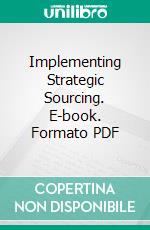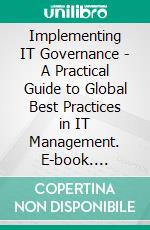Gad Selig eBooks
eBooks di Gad Selig
Implementing Strategic Sourcing. E-book. Formato PDF Gad Selig - Van Haren Publishing, 2010 -
This informative, comprehensive, yet practical guide provides readers with a complete tool-kit of how to approach global sourcing successfully.Based on real world experiences on implementing and sustaining global sourcing the book provides readers with key guidance on:Foundations of Strategic SourcingManagement, risk, governance and legal considerationsOrganizational change, innovation and relationship management Transition planning and the end-game Successful principles for new business development from a service provider perspectiveFuture trends, summary and lessons learnedUltimately this guide will take readers from ‘principles’ to ‘how to’s’ including:How to develop, implement, manage and govern an effective global sourcing strategy and planHow to put in place policies and processes that can be monitored to provide a balanced approach to sourcing How to build a strategic top-down framework coupled with an operational roadmapHow to incorporate bottom-up implementation principles and practices that workHow to ensure a coordinated, cost-effective and value-delivery plan and operating environment for strategic and tactical sourcing.In addition, it addresses the following areas in a comprehensive, yet easy to use and practical manner:Integrates strategic and operational concepts and practicesCovers both clients and providers Supports the practice of global sourcing by leveraging and integrating professional rigor for best practices Provides practical knowledge, techniques, checklists and methodologies that can be used in any environment globallyIncludes many examples of current and emerging best practicesIs broad and comprehensive, yet drills down to specific ‘how to’ details in all chaptersProvides a global view of sourcingIt comes highly recommended.
Implementing IT Governance - A Practical Guide to Global Best Practices in IT Management. E-book. Formato PDF Gad Selig - Van Haren Publishing, 2008 -
The issues, opportunities and challenges of aligning information technology more closely with an organization and effectively governing an organization’s Information Technology (IT) investments, resources, major initiatives and superior uninterrupted service is becoming a major concern of the Board and executive management in enterprises on a global basis. An integrated and comprehensive approach to the alignment, planning, execution and governance of IT and its resources has become critical to more effectively align, integrate, invest, measure, deploy, service and sustain the strategic and tactical direction and value proposition of IT in support of organizations.Much has been written and documented about the individual components of IT Governance such as strategic planning, demand (portfolio investment) management, program and project management, IT service management and delivery, strategic sourcing and outsourcing, performance management and metrics, like the balanced scorecard, compliance and others. Much less has been written about a comprehensive and integrated IT/Business Alignment, Planning, Execution and Governance approach. This new title fills that need in the marketplace and gives readers a structured and practical solutions using the best of the best principles available today. The book is divided into nine chapters, which cover the three critical pillars necessary to develop, execute and sustain a robust and effective IT governance environment - leadership and proactive people and change agents, flexible and scalable processes and enabling technology. Each of the chapters also covers one or more of the following action oriented topics: demand management and alignment (the why and what of IT – strategic planning, portfolio investment management, decision authority, etc.); execution management (includes the how - Program/Project Management, IT Service Management with IT Infrastructure Library (ITIL) and Strategic Sourcing and outsourcing); performance, risk and contingency management (e.g. includes COBIT, the balanced scorecard and other metrics and controls); and leadership, teams and people skills.

